SciTech Tuesday: Harry Daghlian and ‘The Demon Core’
Having sent a uranium bomb to the Pacific Theater, tested a plutonium core at Trinity, and sent another plutonium core to the Pacific Theater, Los Alamos received the plutonium for another plutonium core. The plutonium was sent to the metallurgy group to be pressed into two hemispheres and nickel plated. The plan was to build another plutonium bomb to be delivered to the Pacific Theater for a bombing on August 17 or shortly after that. The announcement of Japan’s surrender on August 15 changed those plans.
The core stayed in the lab at Los Alamos, where it was to be studied to ascertain better ways to achieve critical mass. The idea was to make a core that was just 5% below critical mass and then put it inside a set of neutron reflectors. These neutron reflectors would decrease the mass necessary for criticality.
Harry Daghlian, a young graduate student from Purdue University, had joined Otto Frisch’s team at Los Alamos. This team was in charge of designing ways to assemble a core that would reach critical mass and explode. Plans to develop a more reliable and more powerful nuclear weapon were under way even before the use of the first two bombs.
On August 21, 1945, Daghlian was building a box of tungsten carbide bricks around the plutonium core when he accidentally dropped a ring right next to the core. This caused the core to go immediately supercritical. The response of the neutron detectors used in the investigation told what had happened, and he removed the bricks from around the spherical core. He prevented a worse disaster by his quick response, but suffered a fatal dose of radiation, estimated at 200 rad of neutron radiation and 110 rad of gamma radiation. He was taken to a hospital and isolated, dying 25 days later of radiation poisoning. This was the first known criticality accident, and little was known of the effects of acute radiation exposure. The only other staff member nearby was a security guard sitting about 4 m away. He died of acute myelogenous leukemia 33 years later.
On May 21, 1946, Louis Slotin and 7 other physicists were using the same core to test beryllium spheres as neutron deflectors. Slotin had an (unapproved) procedure where he lowered the top beryllium sphere onto the core while holding a screwdriver angled on the edge of the bottom reflector sphere to keep them from fully closing. He was leaving Los Alamos, and was showing his replacement the procedure when the screwdriver slipped, the spheres enclosed the plutonium core, and it went super-critical. Slotin flipped the top sphere off the core quickly, but not before receiving an estimated 1000 rad of neutron radiation and 114 rad of gamma radiation. The other 6 scientists were standing behind him, and so were mostly shielded by his body. Alvin Graves, who was closest to Slotin, received 166 rad of neutron and 26 rad of gamma radiation. Slotin died 9 days later of radiation poisoning. Graves, who was hospitalized for several weeks of treatment, left the hospital with neurological and vision problems. He died 19 years later, at the age of 53, of heart failure.
This plutonium core, the third ever made, was detonated during on of the Operation Crossroad tests on Bikini Atoll on July 1, 1946. It was detonated using two beryllium spheres just like Slotin and Graves were testing.
Posted by Rob Wallace, STEM Education Coordinator at The National WWII Museum.
- Daghlian started his undergraduate studies at MIT before transferring to Purdue, where he got his bachelor's degree and began his PhD studies.
- A reconstruction of the mechanism being tested when Slotin and Graves were exposed.
- Graves died of a heart attack while skiing. He suffered from vision and other neurological problems after his acute radiation exposure.
- Louis Slotin's Los Alamos ID. He normally wore jeans and a cowboy hat to the lab.
- A reconstruction of the device Daghlian was using to test reflection of neutrons onto the plutonium core.
all images from Wikimedia Commons


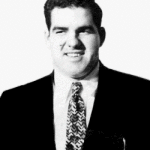
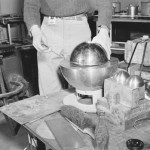
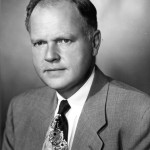
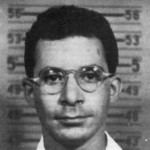
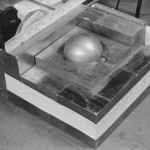


Leave a Reply